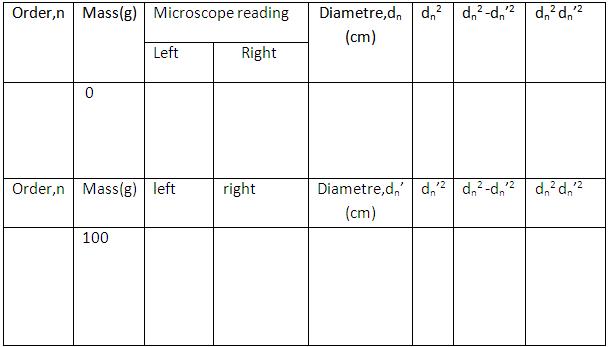Cornu's Method
Apparatus
- Sodium vapor lamp
- Transparent beam
- Convex lens
- Travelling microscope
- Two knife edges
- A set of weights
- Weight holders
- Mirror
Experimental Set Up

Consider a rectangular Perspex beam of length L, breadth a, and thickness b. A plano-convex lens is placed over the beam. Weight hangers are placed at both ends, where mass can be added. Knife edges are positioned at a distance l from both weight hangers. A light source is used to illuminate the arrangement.
Procedure
1. Real Lab
To Find the Diameter of Rings Without Mass
- Place the given Perspex beam symmetrically over the two knife edges.
- A convex lens is placed over the beam.
- As shown in the figure, light is allowed to fall normally on the air film with the help of a glass plate.
- On focusing, interference fringes formed are viewed by means of a travelling microscope.
- Fix the cross wire on any of the nth ring on one side (left or right) using the knob.
- Note the corresponding value of MSR (Main Scale Reading) and VSR (Vernier Scale Reading).
- Move the cross wire to the (n−1)th or (n−2)nd ring on the same side.
- Take the readings of the rings on either side of the center position.
- Now repeat the same procedure by moving the cross wire up and down on either side of the center position.
Diameter of Rings With Mass
- Adjust the distance between the weight hanger and the knife edges.
- Add mass on the weight hanger.
- Repeat steps 4–9 to measure the horizontal and vertical position of rings.

2. Simulator
To Find the Diameter of Rings Without Mass
- Set the mass on the weight hanger to 0 g.
- Select desired values for the variables by clicking on the sliders for each variable.
- Click on the ‘Light On’ button.
- Now repeat steps 5–9 of the Real Lab procedure.
- The reading of rings during the horizontal/vertical motion is shown by the horizontal/vertical position value of the microscope under the Variables section.
- Click the ‘Reset’ button to enter another set of variable values.
To Find the Diameter of Rings With Mass
- Adjust the variables and the position of the weight hanger by clicking on their corresponding sliders.
- Add a suitable mass on the weight hanger.
- Repeat steps 3–6 of the Simulator section.
Observations
To Find the Thickness of the Perspex Beam Using Screw Gauge
Zero correction=

Thickness of Perspex beam, b=...........mm
To find the breadth of Perspex beam using Vernier calipers

Breadth of plate, a=..........cm
To find the diameter of rings in horizontal direction
λ=..........nm,
l=.............cm

Longitudinal bending R1
To find the diameter of rings in vertical direction

Lateral strain, R2
Results
For a given plate
- Young’s modulus, Y = ................... Nm⁻²
- Poisson’s ratio, σ = ..................
- Bulk modulus, B = ...................... Nm⁻²
